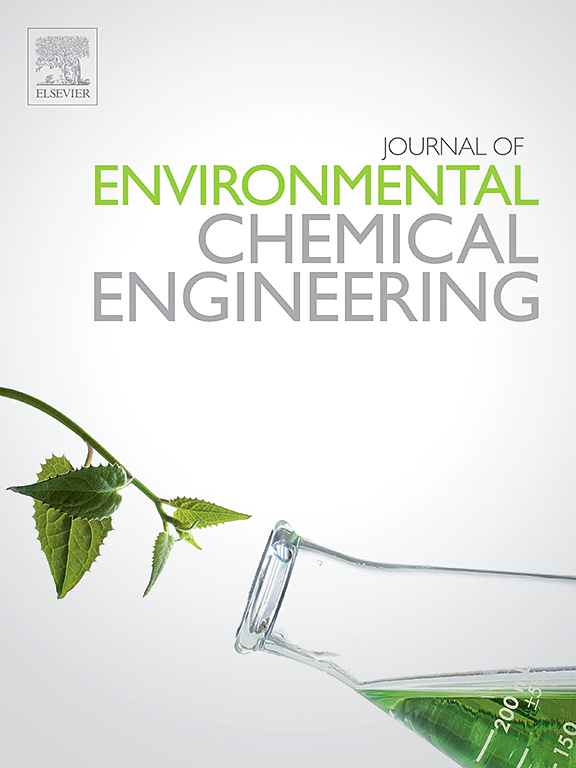青生红球菌SCJ-1对正己烷生物降解的代谢和酶学研究
IF 7.4
2区 工程技术
Q1 ENGINEERING, CHEMICAL
引用次数: 0
摘要
正己烷是一种具有神经毒性的挥发性有机化合物,普遍存在于工业排放物中,由于其疏水性而难以生物降解,因此对环境和健康构成风险。从制药废水污泥中分离到的青生红球菌(Rhodococcus qingshenggii)菌株SCJ-1通过16S rRNA测序鉴定,表现出较强的降解能力。全基因组测序显示该菌株携带一系列与烷烃降解相关的基因。经Haldane生长模型优化,菌株SCJ-1在pH 7.0和30℃条件下,在浓度为200 mg·L−1的条件下,在48 h内降解了82.3 %的正己烷。在此条件下,烷烃羟化酶(AlkB: 27.6 nmol·mg−1蛋白)催化正己烷的初始羟基化反应,而醇脱氢酶和醛脱氢酶(ADH/ALDH: 37.3 nmol·mg−1蛋白)催化正己烷的顺序氧化生成醛和羧酸。同时,超氧化物歧化酶(SOD: 10.9 mmol·mg−1蛋白)、过氧化氢酶(CAT: 34.5 mmol·mg−1蛋白)和总抗氧化能力(T-AOC: 42.2 mmol·mg−1蛋白)共同减轻了氧化应激,增强了酶的稳定性。气相色谱-质谱分析(GC-MS)检测到戊酸和丁酸乙酯,表明存在Baeyer-Villiger单加氧酶(BVMO)介导的降解途径。为了研究BVMO的代谢物选择性以及戊酸和丁酸乙酯的来源,通过分子对接证实了其对2-己酮的特异性(结合能为−3.925 kcal·mol−1)。这些结果表明,菌株SCJ-1是生物修复的有效候选者,利用新的bvmo驱动途径可持续控制正己烷污染。本文章由计算机程序翻译,如有差异,请以英文原文为准。
Metabolic and enzymatic insights into n-hexane biodegradation by Rhodococcus qingshengii strain SCJ-1
n-Hexane, a neurotoxic volatile organic compound ubiquitously present in industrial emissions, poses environmental and health risks due to its recalcitrance to biodegradation stemming from its hydrophobic nature. The strain Rhodococcus qingshengii strain SCJ-1, isolated from pharmaceutical wastewater sludge through adaptive enrichment and identified via 16S rRNA sequencing, exhibited robust degradation capabilities. Whole-genome sequencing showed that the strain carries a wide array of genes related to alkane degradation. Following optimization using the Haldane growth model, under conditions of pH 7.0 and 30℃, the strain SCJ-1 degraded 82.3 % of n-hexane at a concentration of 200 mg·L−1 within 48 h. Under these conditions, alkane hydroxylase (AlkB: 27.6 nmol·mg−1 prot) catalyzed the initial hydroxylation of n-hexane, while alcohol dehydrogenase and aldehyde dehydrogenase (ADH/ALDH: 37.3 nmol·mg−1 protein) drove its sequential oxidation to aldehydes and carboxylic acids. Concurrently, superoxide dismutase (SOD: 10.9 mmol·mg−1 protein), catalase (CAT: 34.5 mmol·mg−1 protein), and total antioxidant capacity (T-AOC: 42.2 mmol·mg−1 protein) collectively mitigated oxidative stress, enhancing enzyme stability. Gas chromatography-mass spectrometry (GC-MS) analysis detected pentanoic acid and ethyl butyrate, indicating the presence of a Baeyer–Villiger monooxygenases (BVMO)-mediated degradation pathway. To investigate the metabolite selectivity of BVMO and the origin of pentanoic acid and ethyl butyrate, molecular docking confirmed its specificity for 2-hexanone (binding energy of −3.925 kcal·mol−1). These results suggest that the strain SCJ-1 is an effective candidate for bioremediation, utilizing a novel BVMO-driven pathway for the sustainable control of n-hexane pollution.
求助全文
通过发布文献求助,成功后即可免费获取论文全文。
去求助
来源期刊

Journal of Environmental Chemical Engineering
Environmental Science-Pollution
CiteScore
11.40
自引率
6.50%
发文量
2017
审稿时长
27 days
期刊介绍:
The Journal of Environmental Chemical Engineering (JECE) serves as a platform for the dissemination of original and innovative research focusing on the advancement of environmentally-friendly, sustainable technologies. JECE emphasizes the transition towards a carbon-neutral circular economy and a self-sufficient bio-based economy. Topics covered include soil, water, wastewater, and air decontamination; pollution monitoring, prevention, and control; advanced analytics, sensors, impact and risk assessment methodologies in environmental chemical engineering; resource recovery (water, nutrients, materials, energy); industrial ecology; valorization of waste streams; waste management (including e-waste); climate-water-energy-food nexus; novel materials for environmental, chemical, and energy applications; sustainability and environmental safety; water digitalization, water data science, and machine learning; process integration and intensification; recent developments in green chemistry for synthesis, catalysis, and energy; and original research on contaminants of emerging concern, persistent chemicals, and priority substances, including microplastics, nanoplastics, nanomaterials, micropollutants, antimicrobial resistance genes, and emerging pathogens (viruses, bacteria, parasites) of environmental significance.
 求助内容:
求助内容: 应助结果提醒方式:
应助结果提醒方式:


